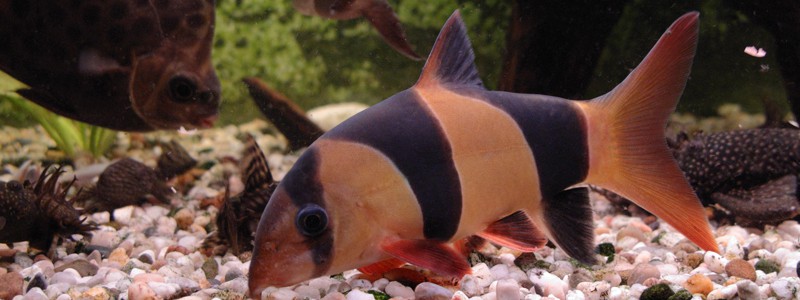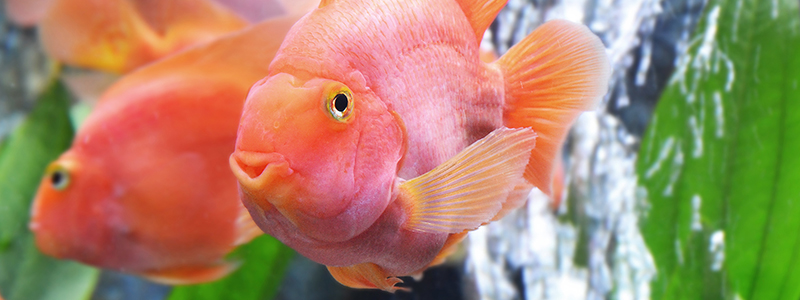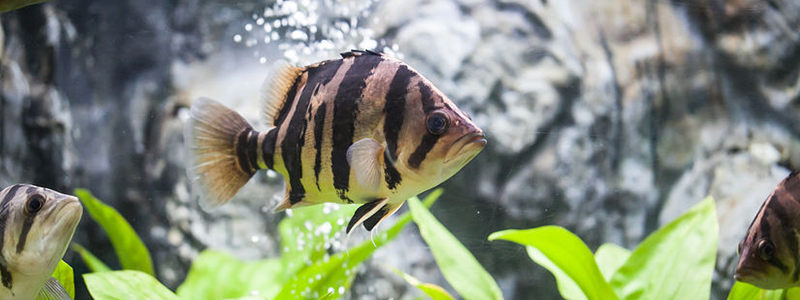Quick Overview
- Family: Cobitidae
- Scientific Name: Chromobotia macracanthus
- Care level: Moderate to challenging
- Temperament: Peaceful
- Diet: Omnivorous
- Water conditions: Warm, clean water with plenty of movement
- Max Size: 18 inches
- Minimum tank size (as an adult): 55 gallons
Overview: Clown Loach Care
The name might imply that this fish is a total joke, but trust us – it’s not. Raising a clown loach fish is certainly no laughing matter, but we can promise you that you will have a blast doing it. As one of the most popular – yet challenging – aquarium species, the clown loach is not the fish to raise for the faint of heart. However, it can provide a number of benefits to your large aquarium if you are ready to give the breed a try.
The clown loach fish is a large freshwater species that was originally discovered in Indonesia on the islands of Sumatra and Borneo. This colorful striped fish is now one of the most popular fish for pet owners, available at a majority of local pet stores.
This beautiful fish is valued for its vibrant coloring and active personality. These fish grow quite large, and while they are always moving, they can be somewhat shy around humans. They enjoy being around other fish, making them a good option for a large aquarium ecosystem.
These unique fish have a number of behaviors, including mating and defense rituals, that make them an interesting species to observe. When the fish senses it is in danger, it will make a chattering noise and raise its spines. For the most part, these fish will spend the majority of their time hanging out at the bottom of your tank. They are peaceful and relaxed, and despite being active fish will also spend much of the day relaxing in the sand.
Clown Loach Lifespan
Clown loaches are reported to live 20 years to an upwards of 30 years. To reach the end of the spectrum a clown loach keeper must make sure that they maintain great water quality and provide enough space. These fish prefer living in schools and can reach 12 inches on average. If you plan on keeping at least six clown loaches, the tank size you’re going to need is
Clown Loach Appearance
These fish are some of the most vibrantly and uniquely colored of all freshwater species. They have movable spines just below their eyes. This spine is an attractive, interesting feature, but if you are handling a clown loach you need to take care not to touch it, as it can deliver an excruciatingly painful wound. This spine is not venomous, but you will definitely know you have been stung.
Loaches have a narrow body shape, usually in vibrant orange-yellow color. They have two wide, V-shaped bands that run up and down their sides. These are usually black. There is also a thinner black band that runs through the eye. Both the tail fin as well the paired fins are red. These fish have an unmistakable appearance that allows them to stand out among their tank mates. They have thin scales, giving them an almost translucent appearance.
What size are clown loaches when they’re small?
Most clown loaches sold at pet stores are babies or juveniles and are only about an inch and a half to three inches in length. This is because it is nearly impossible to ship fully grown clown loaches. That said, once they’ve acclimated to your aquarium, they will grow several inches in a short period of time.
How fast/slow should you expect them to grow?
Clown loaches will reach about five inches in length in roughly two years. After that rapid period of growth, they will grow, on average, about half an inch to two inches for every subsequent year. This varies, obviously, depending on the individual fish and tank conditions, but it should be noted that these fish can grow quite large.
What is the max size of clown loaches?
At their largest, clown loach can grow up to ten inches in length – with some reports of them growing well over 18 inches! As a result, this fish species needs a lot of space and room to grow.
Different types of loaches
In addition to the clown loach, there are several other common loaches that are frequently raised by fish hobbyists. These include:
- Red finned loach
- Dwarf loach
- Skunk loach
- Zebra loach
- Bengal loach
- Burmese border loach
- Yoyo loach
Clown Loach Diet & Feeding
What do clown loaches eat in the wild?
In the wild, clown loaches are omnivores, feeding on just about anything that comes their way. They will eat insects, plant matter, and even small invertebrates.
Clown Loach Feeding Habits
You should feed your clown loach a diet that is comprised mostly of high-quality foods, such as flakes and shrimp pellets. While live or frozen food can be fed as treats, these should not part of a loach’s regular diet. Clown loach fish will also eat snails. They prefer smaller species as a general rule.
What foods are recommended?
When it comes to foods, pellets are always going to be the cheapest option. This doesn’t mean you’re limited to pellets, feel free to mix up your fish’s diet!
Be careful if you are housing clown loach with other species of fish, as they will often refuse to eat food from the water’s surface. As a result, any of your attempts to feed them will be foiled, as the other fish will eat the food before the loaches can get to it. Instead, feed them sinking food that goes directly to the bottom of the tank. Some options include blood worms, brine shrimp, and black worms. This is a great food choice to feed your Clown Loach fish!
You can even feed your clown loaches vegetables! They prefer small pieces of zucchini, peas, and more. Try to limit vegetable feeding to about once a week, and consider substituting fresh or frozen vegetables with herbivore flakes.
Clown Loach Tank Setup
[su_youtube_advanced url=”https://www.youtube.com/watch?v=1zskh3NuZQo” autohide=”yes” rel=”no” https=”yes”]Natural habitat of clown loaches
In the wild, clown loach tend to live in rapidly moving bodies of water, such as running streams and rivers. That being said, these fish often migrate to forests, fields, and swampy areas during heavy monsoon floods. They do prefer swiftly moving bodies of water, however, which is something you should keep in mind when planning out your aquarium. Clown loaches also are a schooling fish, meaning they tend to live in large groups.
Clown Loach Tank size
One Adult Clown Loach: 55 gallons
Six Adult Clown Loaches: 150 gallons
You can keep clown loaches in smaller tanks when they are young because they have a slow pattern of growth. It may be several years before you need to move them to a larger tank. For juvenile clown loaches, you only need a tank that is about 55 gallons total. Once they progress toward adult growth, you should upgrade to a tank that is minimum of 125 gallons.
You need to provide clown loach with plenty of space to grow, as they can grow to an average of 12 inches. Small tanks WILL stunt the growth of your clown loaches, possibly leading to a shortened lifespan. Keep in mind, too, that clown loach can live for many years, meaning you will need to place and set up their aquariums with this longevity in mind.
Clown loach fish prefer to be kept in schools of six or more. This will increase the minimum tank size quite substantially. Keeping clown loaches in groups of less than six will cause them to become stressed, and they will end up spending much of their time hiding. That being said, you don’t need to have six clown loach in order to have an adequate school. They will school with most other types of fish, even if they are of varying sizes. This is a sharp contrast from other schooling fish, which often school only with fish of comparable sizes.
Your clown loaches will also need a powerful filter. They need a large amount of current in their tanks to simulate their natural environment. Provide either a powerhead or a large hang-on-back filter.
Water conditions (Temperature, pH, KH)
Clown loaches can tolerate a wide range of pH and any moderate hardness. Ideally, they should be in the pH range of 6.5 to 7.5. They prefer warmer temperatures similar to that of their native climate, with an ideal ranging from the high 70s to mid-80s Fahrenheit. Provide plenty of water movement, but also quiet places to hide.
Decorations
Because clown loaches are naturally found in streams with ample plant life, an aquarium should also have large rocks, sand, and a number of plants. Sand or small-grained pebbles are a good idea for a bottom layer. You should also provide them with at least one hiding spot, such as a cave. You might also consider putting the tank in a shady corner or adding vegetation to provide plenty of shadowy, dark places. Avoid adding too much supplemental lighting, as this can cause them stress.
Keep in mind that you need to observe the quality of your decorations carefully once you introduce clown loach. They will happily eat all of your plants – including artificial ones, but especially plants like Echinodorus. You can help prevent this by introducing plenty of plant food into the clown loach’s diet. This will help decrease the likelihood it will gnaw on your plants.
Clown Loach Tank Mates
You absolutely need to provide your clown loach with plenty of tank mates, ideally a few of its own species, although your stock can be diverse. Try to find tank mates that have a similar diet to the clown loach, and avoid those that solely feed on the water’s surface, as they can have a tendency to steal your loach’s food before it sinks to the bottom.
What follows is a list, which is by no means comprehensive, of species with which clown loach cohabitate well.
- Bosemani Rainbow
- Cherry Barb
- Dwarf Neon Rainbow
- Penguin Tetra
- Red Tailed Shark
- Three Spotted Gourami
- Zebra Danio
- Ropefish
- African Cichlids
- Kuhli loach
- Swordtails
- Big Tetras
General Behavior of Clown Loaches
Clown loaches are very active fish and also need extensive social stimulation. They should be kept in large groups of at least six since they tend to school. When you first introduce your new clown loaches, you may be startled because these fish have the tendency to disappear for several days at a time. They will sometimes lay on their side and play dead, which can be frightening for a beginner aquarium hobbyist.
However, this usually happens when the pH of a tank is low or unfamiliar, causing the loach to stress. It needs some time to acclimate, but after a few days should adjust and carry on normally.
How to Keep Clown Loach Healthy
Common diseases to look out for
Clown loaches are particularly susceptible to ich, and it can be challenging to treat your fish once it’s acquired the disease. As clown loaches do not have scales, they often don’t respond to traditional ich medications that contain malachite green, formatite, or copper. To date, quinine is the only known treatment that works to combat ich in clown loaches.
Ich can also be prevented by purchasing fish that have been in the fish tore for at least one week. Ich-susceptible loaches usually come down with this disease in the first week, so you’ll be able to tell if they have it. If you suspect your loach to have ich, quarantine it immediately for at least two weeks.
Tips on keeping clown loach in good health
Clown loaches are one of the most finicky species when it comes to water quality in the tank. Because they are so susceptible to ich, they are usually one of the first fishes to die when your water quality takes a nosedive. Therefore, if you are a beginner aquarium hobbyist, it is recommended you consider your decision to purchase a clown loach very carefully. It can be difficult to moderate water conditions perfectly in order to raise a healthy clown loach.
That being said, it can be done. Consider setting up a quarantine tank for any new fish you plan on adding to your aquarium. This will help limit the spread of diseases your fish may have picked up at the pet store, and also allow you to keep an eye on them during the transition. Once your fish have all been acclimated to the new tank and to each other, you can also add vitamin enriched flakes and wafers to boost their immunity. Watching for signs of disease, as well as frequently cleaning the tank, are also good ways to keep your loaches in good health.
Breeding Clown Loaches
Most people choose not to breed clown loaches in the home, making breeding clown loaches an extremely rare process. However, you can take several steps to increase your success in breeding them if you choose to do so.
First, make yourself aware of the sex differences between clown loaches. You often cannot tell the difference in sexes until the fish are already mating. When a female has eggs inside her, she will have a slightly rounded abdomen. Male fishes will also have more pronounced pelvic fins.
Make sure you have a sexually mature breeding pair. Because clown loach has the ability to live for so many years, you may have to wait several years to have a pair of this caliber. To determine whether they are ready to be bred, look at their size first. A mature fish will be at least six inches long. Males will also possess tailfins that bend slightly inward.
When they’re ready to breed, keep them in a tank with well-maintained water. Condition them by feeding with live food several times a day, which will cause your females to rapidly gain weight. Mating will take place within a few weeks, and eggs will hatch within several days.
Fry will become free-swimming after several days and can be fed commercial fry food for about two weeks, at which point they will be large enough to proceed with a normal adult feeding schedule.
Interesting facts
One of the most interesting facts about Clown Loaches is that they’re rarely bred in captivity. These fish are usually “farmed” in the wild, meaning breeders usually extract them from their natural environment and then grow them out in a large pond. This is very difficult to do in the United States, as the climactic factors prove to be a hindrance.
Despite the difficulty in rearing them, clown loaches remain one of the best aquarium species for controlling nuisance snails. They can help cut down on snail populations while also adding a pop of color to your otherwise bland tank.
Is a Clown Loach Right For You?
Keep in mind the environment you have to offer a clown loach. If the maximum size tank you can fit in your living room is only 55 gallons, then these rapidly growing fish may not be for you. Similarly, if you already have quite a few fish, you may not have enough room. On the flip side, if you only want one or two fish, again, a clown loach might not be the right choice.
That said, clown loaches are beautiful, active fish that will last you several years at the very least. These fish make a great addition to any tank, and while you must be vigilant bout providing them with the ideal conditions, these fish are an excellent choice that will provide you with entertainment and enjoyment for years to come.






